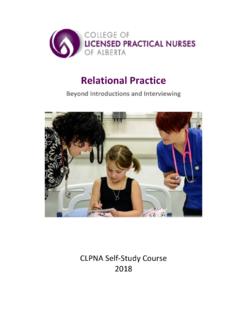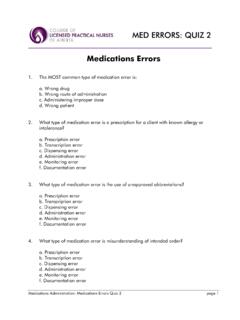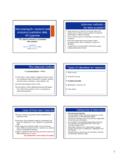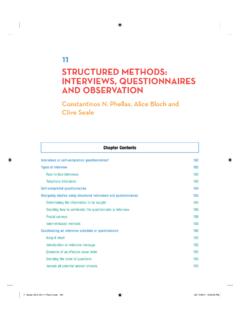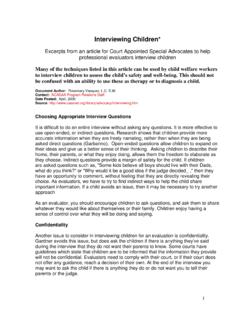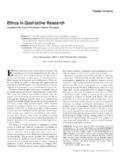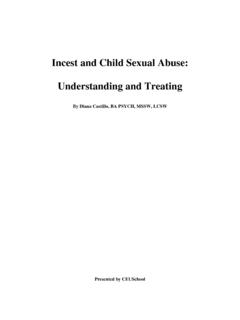Transcription of Relational Practice - Study with CLPNA
1 Relational Practice Beyond Introductions and interviewing CLPNA Self- Study Course 2018. Legal and Copyright T hese modules are intended to support the continuing education of Alberta's Licensed Practical Nurses. This course is a refresher and is not a substitute for accreditation or training. Always follow your employer's policies and procedures. College of Licensed Practical Nurses of Alberta 2018. Published by: College of Licensed Practical Nurses of Alberta ( CLPNA ). St. Alberta Trail Place 13163 - 146 Street NW. Edmonton, Alberta, Canada T5L 4S8. Phone: 780-484-8886. Website: Email: Acknowledgements T he development of this resource guide is an initiative of the College of Licensed Practical Nurses of Alberta ( CLPNA ). Production of this professional development initiative has been made possible through a grant from Alberta Labour, Foreign Qualification Recognition branch.
2 Content and Review Melodie Hull, RPN, MSc, MEd is the author of this CLPNA 's Relational Practice course. She is a Registered Psychiatric Nurse and Nurse-Educator. In her years of nursing Practice and then as an educator, she has worked with nurses and student nurses in Practical Nursing (LPN), Psychiatric Nursing (RPN), and Registered Nursing (RN). Melodie specializes in education related to medical and nursing language. She is the author of a number of books and journal articles and is internationally recognized for her work. In addition to nursing, she holds a graduate degree in Teaching English for Specific Purposes. Melodie's most recent book, Medical Language: terminology in context is available on-line through major booksellers around the world. Design and Programming Russell Sawchuk of Steppingstones Partnership, Inc.
3 And Learning Nurse Resources Network was responsible for the design and programming of this course. Table of Contents Chapter 1: Introduction and Overview .. 1. Overview .. 1. How to use this Study Guide .. 1. Evaluation .. 1. Topic #1: Review of professional communication .. 1. Topic #2: Relational Practice defined .. 4. Summary .. 4. Review exercise .. 4. Glossary .. 5. References .. 5. Review exercise answers .. 5. Chapter 2: Review of Core Relational Practice Skills .. 6. Overview .. 6. Topic #1: Relational Practice .. 6. Topic #2: Posing 8. Topic #3: Rapport .. 9. Summary .. 11. Review exercise .. 11. Glossary .. 12. References .. 12. Review exercise answers .. 12. Chapter 3: Client-centered Relational Practice (RP) .. 13. Overview .. 13. Topic #1: Professionalism reviewed.
4 13. Topic #2: Professional boundaries reviewed .. 15. Topic #3: Language of Relational Practice .. 16. Topic #4: Concept of Relational inquiry .. 18. Summary .. 19. Review exercise .. 19. Glossary .. 19. References .. 20. Review exercise answers .. 20. Thoughts about case Study (Figure 6) .. 20. Chapter 4: Collaborative and Collegial Relational Practice .. 21. Overview .. 21. Topic #1: Cultural and professional norms in the workplace .. 21. Topic #2: Collaborative and collegial Relational Practice .. 24. Topic #3: Reporting and documenting .. 26. Topic #4: Delegation .. 28. Topic #5: Conflict and resolution .. 29. Summary .. 30. Review exercise .. 30. Table of Contents Chapter 4: Collaborative and Collegial Relational Practice (continued). Glossary .. 31. References.
5 31. Review exercise answers .. 32. Reflection on delegation exercise .. 32. Chapter 5: Relational Practice with Healthcare Team Members .. 33. Overview .. 33. Topic #1: Status on the Canadian care team .. 33. Topic #2: The assertive nurse .. 34. Topic #3: Communicating with the physician .. 35. Topic #4: Gender-based communication .. 38. Summary .. 39. Review exercise .. 39. Glossary .. 39. References .. 40. Review exercise answers .. 40. Chapter 6: Relational Practice for Continuity of Care .. 41. Overview .. 41. Topic #1: Acute care and community care .. 41. Topic #2: Continuity of care .. 42. Topic #3: Sharing across care sites: legal and professional boundaries .. 45. Topic #4: Skills of reporting, team-to-team .. 46. Summary .. 47. Review exercise .. 47. Glossary.
6 47. References .. 48. Review exercise answers .. 48. Reflections on Jagdeep case Study .. 48. Chapter 7: Relational Practice with Indigenous Peoples .. 49. Overview .. 49. Topic #1: Impetus and rationale .. 49. Topic #2: Coming to know .. 50. Topic #3: Relational Practice .. 54. Topic #4: The way forward .. 55. Summary .. 56. Review exercise .. 57. Glossary .. 58. References .. 58. Review exercise answers .. 59. Chapter 1: Introduction & Overview Overview understanding that communication is a key element within it. Welcome to Relational Practice : Beyond introductions and interviewing ! How to Use the Study Guide This course is delivered through a Study Guide. It L PNs realize there is much more to nursing communication than making introductions and interviewing .
7 To work effectively with clients, is self-paced meaning you can do it on your own time and schedule. Chapters include exercises that help LPNs think about their Relational LPNs need professional communication skills that Practice . Take the time to do these to reinforce build relationships with them. Sometimes these what is being read. Turn reading into stored relationships are referred to as helping knowledge and develop your nursing Practice in a relationships, interpersonal relationships, or meaningful way! Quizzes and self-assessments are therapeutic relationships. But note what isn't said also included for additional learning. but is implied. Each of these places the client first and foremost. They also help nurses learn the Each Chapter is designed around key topics.
8 For skills of being in relation' with the entire team examples, the topics in this one are: revolving around the client. This includes loved ones, significant others, groups and cultures, the 1) Review of Professional Communication interprofessional team and the public. Relational 2) Relational Practice Defined Practice is a new approach to partnering with clients that builds on general nursing Evaluation communication skills. Upon successful completion of a final examination, The goal of this course is to enhance and advance CLPNA is pleased to offer a certificate of completion the LPNs skills of engagement with clients and for Relational Practice : Beyond introductions and others. Learners will be introduced to the interviewing . This course can be used as a Relational Practice approach as part of that while Continuing Competency activity.
9 Topic #1: Review of Professional Communication P rofessional, interpersonal communication within Relational Practice is the main focus of this course. The context of that communication is Communication is a transaction: an interaction or exchange between the people involved. Communication happens in a loop called the more specific to working with the care team feedback loop. While we might think that some across disciplines and agencies, providing communication is purely one way, like when continuity of care, and being in relation with giving a firm direction to someone, this is not indigenous peoples. Prior to learning about more necessarily so. Communication is generally a two- that, a review of aspects of professional way phenomenon. There is a sender and a communication theory and skills will be helpful.
10 Receiver for the message. Even when the receiver This sets the foundation for a new way of thinking doesn't respond, the message is processed in the about the nurse-client relationship and working mind his or her mind. This is the act of with others: Relational Practice (RP). RP will be interpretation. See Figure 1. incorporated into Chapters as a focus. CLPNA Relational Practice P a g e | 1. Figure 1: A Communications Model Interpretation of messages relies on the receiver's responses. Clarification or rewording may be personal perspectives, experiences and values necessary. and he or she tries to decipher meaning. The responsibility relies on the sender to ensure the Exercise : (PDF | MSWord) Take a look at message is encoded (or worded, demonstrated) in Table 1 about Slang and Colloquial Terms.
